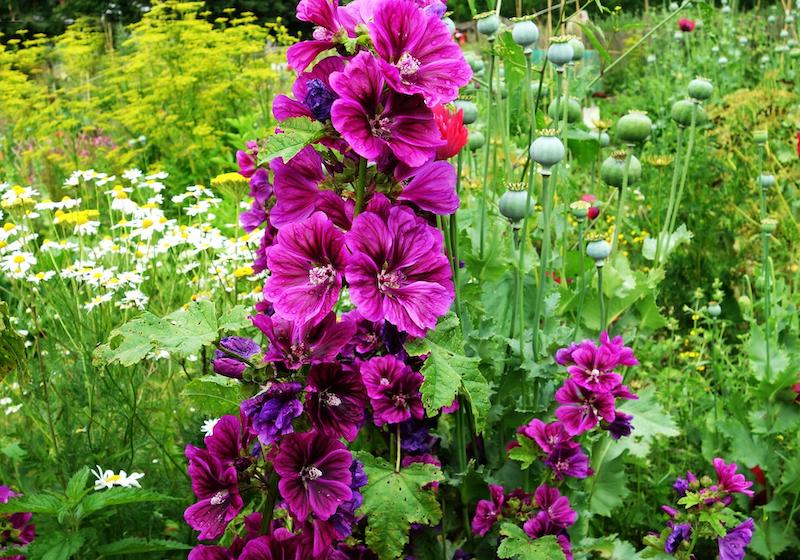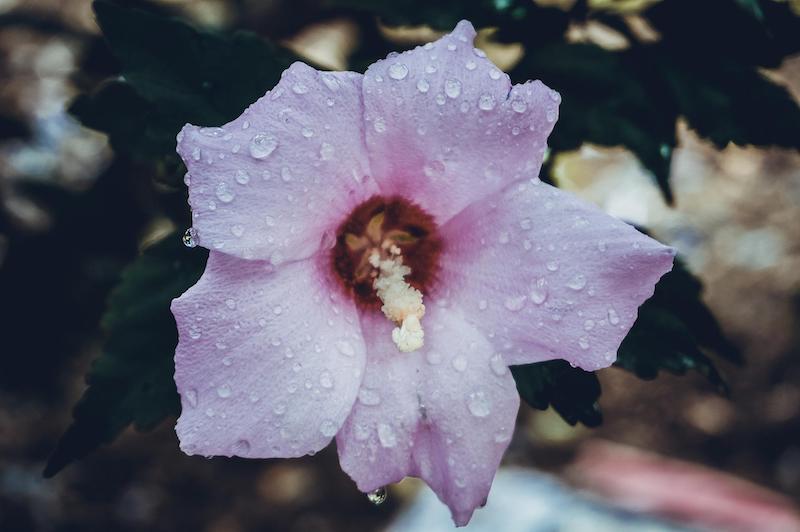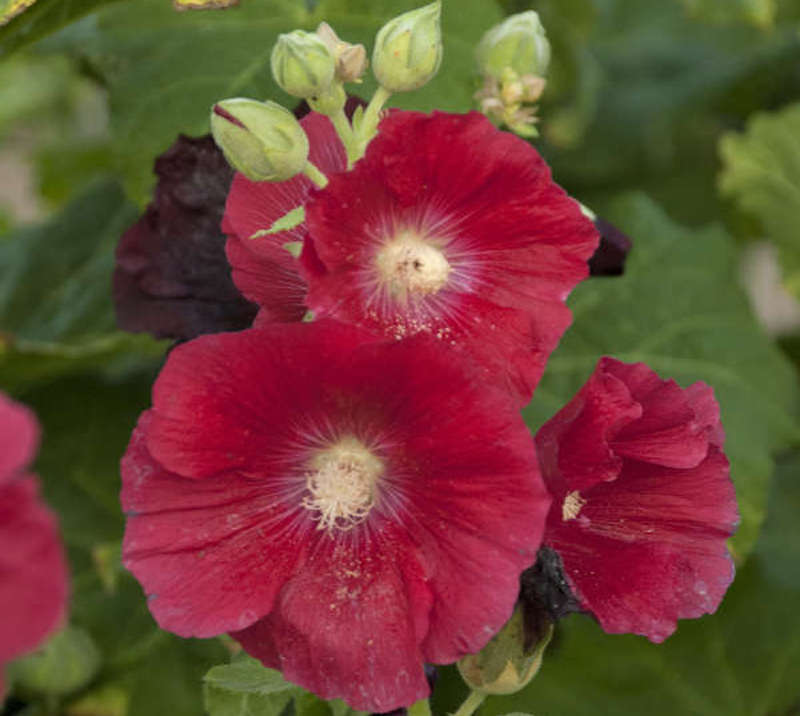Hollyhock is a charming plant with an old-world cottage vibe that is well-loved by gardeners and pollinators. A central, upright stalk can reach up to 8 feet tall, while dwarf varieties reach about 3 feet high. Flowers bloom on short stems along the central stalk, creating a pillar of blooms during the spring and summer. Flowers are the reason people plant Hollyhock. The single or double flowers can be white, red, magenta, or even a deep dark purple that almost looks black. Some cultivars have a dark eye surrounding a visible stamen, while others have ruffled petals, creating fluffy-looking blooms.
Hollyhocks, also known as Alcea, have pretty basic care requirements, but they still need some attention to thrive. This stunner generally needs full sun and rich, moist, well-drained soil. As a whole, Hollyhocks can grow in USDA zones 3 through 9, but many cultivars prefer zones 6 through 8, so always check the tag before selecting a plant. Hollyhocks typically do not bloom until the second growing season. The plants may only last a few years, but they tend to self-seed, so it is common for these plants to persist at different stages in a bed or border.

Planting Hollyhocks
Hollyhocks need a spot with full sun. The central stalk may not grow strong enough in areas with low light, causing the plant to bend or flop over. High winds are a problem for this tall plant, so the ideal planting site will be on the south side of a building or structure, or near trees that will block the wind but not sunlight. Space plants at least 18 inches apart so air can circulate around the foliage because this beauty is prone to fungus and mold.
Watering Hollyhocks
Seedlings and recently transplanted Hollyhocks need consistently damp conditions, so water when the top few inches of soil feel damp. Established plants can handle drier conditions and typically only need water during a dry period. Too much water is damaging, so avoid drowning the plant and overwatering. Loose soil helps excess water drain adequately.

Fertilizing Hollyhocks
Rich soil will help the plants put on height and consistently push out blooms. Amend the soil during planting or top dress the soil each spring with organic compost or manure to support fast and healthy growth. Fertile soil is enough to help Hollyhocks thrive, but fertilizer can give plants the nutrition they need when grown in poor soil. Apply fertilizer every few weeks during the spring and summer when the plant is blooming. A balanced fertilizer, like a formula with an NPK ratio of 10-10-10, is a good choice for Hollyhock.

Pruning Hollyhocks
Remove flowers once they start to fade to allow the plant to direct energy into new blooms. Hollyhock is a prolific self-seeder, so leave some of the faded blooms toward the end of the bloom cycle, so new plants can emerge in the spring. Be ready to thin out new plants or relocate them to improve air flow. Hollyhock plants can be cut back to the ground in the fall.
Caring For Hollyhocks in Pots
Hollyhocks are not well suited to growing in containers. This plant has a deep root system, which is necessary to keep the tall stalks upright. You can grow Hollyhock plants in pots, but select a large pot and place the container in a sunny spot protected from high winds.
Winter Care for Hollyhocks
Spring and summer are the busy seasons for Hollyhocks, and the growth dies back during the winter. Prepare Hollyhocks for winter by trimming the stalk and all growth back to ground level during the fall. New growth and any seeds that fell from spent flowers will emerge in the spring.
Common Hollyhock Care Questions
Why Are My Hollyhock Leaves Drooping?
Drooping leaves or flower stalks, and leaves that wilting or curling are all signs that the hollyhock needs more water.
Why Is My Hollyhock Dying?
Your hollyhock may have a bad case of Hollyhock Rust. It is most prevalent in hot, humid environments and presents with yellow spots on the leaf tops and reddish-brown pustules on the reverse side. If left untreated, the spots eventually grow together and can spread to the stems and cause disfiguring damage to the plant. To treat, remove the affected leaves and discard them in the trash, not the ground. Repeated applications of fungicides such as sulfur, may be necessary. To prevent, water from the bottom during morning hours so the leaves have all day to dry in the sun, avoid planting in a crowded location or up against a building where moisture builds, and keep the area around the plants free of weeds and other debris.
Why Are My Hollyhock Leaves Curling?
Under-watering is a common cause of curling leaves but leafhoppers might also be the culprit here. They suck the sap from the underneath hollyhock leaves, along the edges which causes the ends of the leaves to curl.
Are Hollyhocks Rabbit Resistant?
Hollyhocks are rabbit resistant, but that does not mean they are rabbit-proof!
Why Are Hollyhock Leaves Turning Yellow?
See above for yellowing hollyhock leaves-Hollyhock Rust.
Can Hollyhocks Grow In Shade?
Hollyhocks can do well in partial shade, so long as they're also getting at least 6 hours a day of sunlight. Less sun, fewer blooms.
How Do You Keep Hollyhocks Upright?
Taller hollyhocks may have difficulty staying upright. If they are struggling, try tying them up to stakes or providing a trellis to offer support.
What Is The Growth Rate Of Hollyhocks?
Hollyhocks grown from seed are relatively slow growing and are not likely to flower until their second year.
How Long Do Hollyhock Blooms Last?
Hollyhocks bloom from mid-summer on into fall, June to the end of August or perhaps early September.
Have a question about Hollyhocks? Fill out the form below and we will try and get back to your question as soon as possible. We may even feature your question in this article to help other gardeners!
 |
Author Alison Cotsonas - Published 08-11-2022 |
